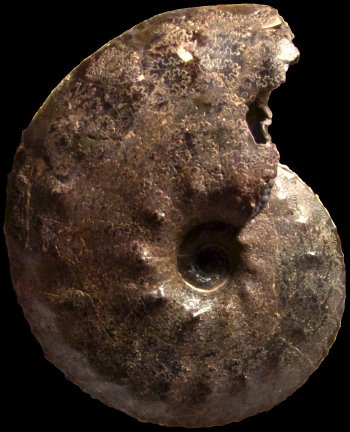

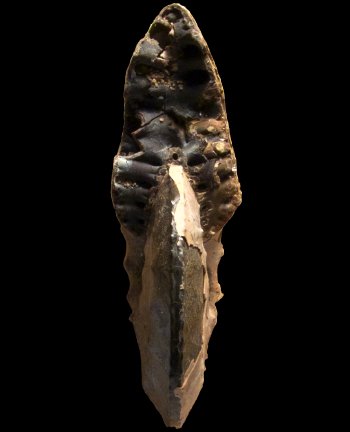

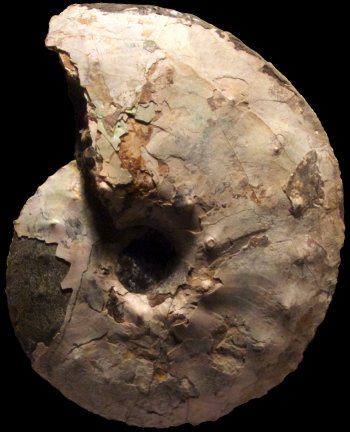

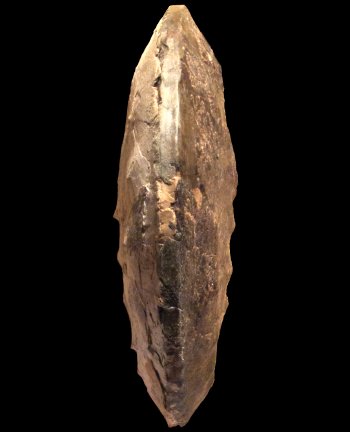


Placenticeras intercalare Meek 1860 |
||
Placenticeras intercalare Meek 1860
Étage
Campanien (-83 à -72 millions d'années) supérieur
Localité
Wyoming - U.S.A.
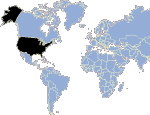
Dimensions
Diamètre = 10,4 cm (4.09")
Commentaire
Classification
Genre :
Placenticeras Meek 1876
Albien sup. à Campanien qup.
Forte variabililité. De formes comprimées, involutes, à flancs convergents un peu bombés, ventre plat et étroit, faibles côtes falcoïdes, bullae ombilicales allongées, tubercules latéro-ventraux internes et externes plus denses, à formes similaires dans les tours internes, puis devenant plus évolutes, à section rectangulaire à carrée, tubercules plus forts, le latéro-ventral interne pouvant migrer d’une position mi-latérale jusqu’au bord ventral tandis que l’externe disparaît.
Famille :
Placenticeratidae Hyatt 1900
Albien supérieur à Maastrichtien supérieur.
Taille moyenne à grande. Les tours internes sont généralement involutes, comprimés, le ventre étroit, plat ou creusé d’un sillon. L’ornementation est discrète ou absente. Les tours externes sont plus évolutes, plus ou moins renflés avec une ornementation forte.
Super-famille :
Hoplitoidea Douvillé 1890
Aptien supérieur à Maastrichtien supérieur
Descendants du genre Uhligella (Desmoceratidae) développant une ornementation robuste typiquement constituée de côtes divisées à partir de tubercules ombilicaux. Beaucoup possèdent un ventre plat ou concave bordé de clavi latéro-ventraux. Le dimorphisme n’est pas parfaitement résolu, mais les microconques ont probablement une ouverture simple. Les sutures sont de type Desmoceratoidea, sauf chez les Placenticeratidae et Engonoceratidae, dont les éléments sont multipliés et développent des caractères particuliers.
Sous-ordre :
Ammonitina Hyatt 1889
Ordre :
Ammonoidea Zittel 1884
Classe :
Cephalopoda Cuvier 1797
Embranchement :
Mollusca Linnaeus 1758
Super-embranchement :
Bilateria: Protostomia Hatschek, 1888: Grobben 1908
Sous-règne :
Eumetazoa Butschli 1910
Règne :
Animalia Linnaeus 1758
Super-règne :
Eukaryota Whittaker & Margulis 1978
Documents
2019. Sealey, P., L. & Lucas, S., G.
Late Cretaceous (Cenomanian-Campanian) ammonite systematic paleontology and biostratigraphy, southeastern San Juan Basin, Sandoval County, New Mexico
in Bulletin of the New Mexico Museum of Natural History and Science - 80 - New Mexico Museum of Natural History and Science
cf. p 156, fig 107A-F, 109, 111I-L, 117 (=Placenticeras cf. P. intercalare (MEEK and HAYDEN, 1860)) - lien
2016. Cobban, W., A.
A survey of the Cretaceous ammonite Placenticeras Meek, 1876, in the United States Western Interior, with notes on the earliest species from Texas
in Acta Geologica Polonica - Vol. 66, No 4 - Université de Varsovie
p 597, text-fig 6, pl 1, fig 4, 5, pl 7, fig 1-3, pl 14, fig 1, 2 (=Placenticeras intercalare MEEK, 1876) - lien
1997. Kennedy, W., J., Cobban, W., A. & Landman, N., H.
Two Species of Placenticeras (Ammonitina) from the Upper Cretaceous (Campanian) of the Western Interior of the United States
in American Museum Novitates - Number 3173 - American Museum of Natural History
fig 6-8 (=Placenticeras intercalare MEEK)
1997. Larson, N., L., Jorgensen, S., D., Farrar, R., A. & Larson, P., L.
Ammonites and the Other Cephalopods of the Pierre Seaway - An identification guide
Geoscience Press, Inc., Tucson Arizona
p 69 (=Placenticeras intercalare MEEK and HAYDEN, 1860)
1934. Bramlette, W., A.
The fauna of the Nostoceras zone of the Taylor formation
The University of Texas at Austin - M.A. Thesis
p 83 (=Placenticeras intercalare MEEK) - lien
1927. Reeside, J., B. Jr.
The cephalopods of the Eagle sandstone and related formations in the Western Interior of the United States
in United States Geological Survey Professional Paper - 151
p 33 (=Placenticeras intercalare) - lien
1903. Hyatt, A.
Pseudoceratites of the Cretaceous
in Monographs of the United States Geological Survey - Volume XLIV - United States Geological Survey - Department of the Interior
p 207, pl XXXV-XXXVII, XXXVIII, fig 1 (=Placenticeras intercalare MEEK) - lien
Contenu révisé le 12 février 2024 - Fiche générée le 12 février 2024 - 1ère publication le 12 août 2016
Phragmocône presque complet (manque une seule loge).
Espèce américaine de la zone à Baculites compressus.
Placenticeras de taille modérée (< 250 mm), relativement comprimé à bullae ombilicales et tubercules latéro-externes aux stades jeune et moyen. A chaque tubercule latéro-externe correspondent trois clavi latéro-ventraux.